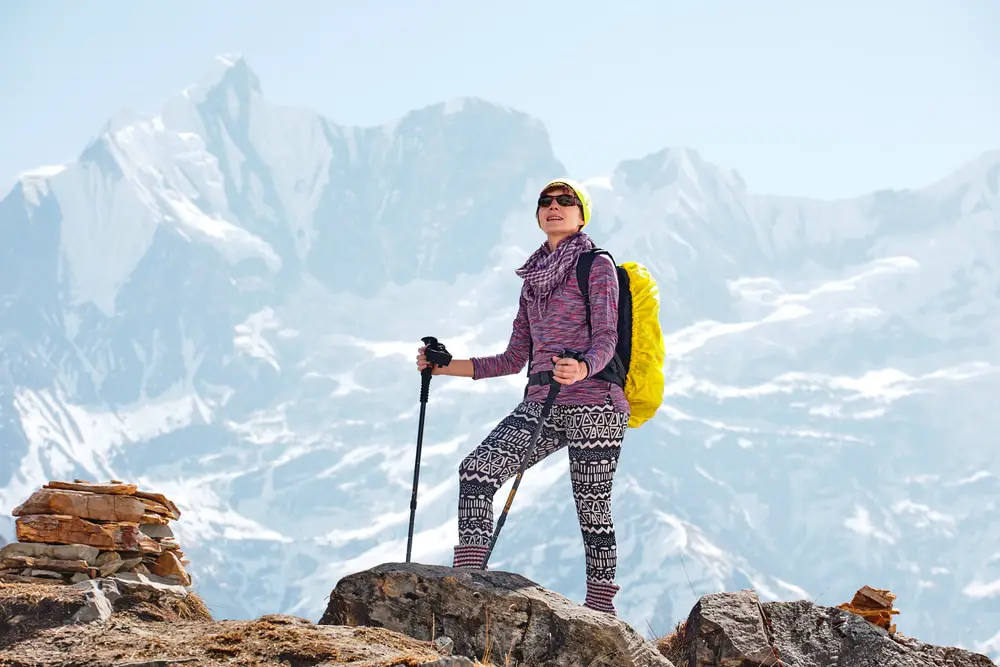It’s a common misconception that layering is a must for hikers only if they are hiking in cold weather, so that they don’t fall ill. Wearing layered clothes is a must whenever you go hiking irrespective of the weather conditions.
Experienced hikers will tell you that wearing just one base layer will not do anything for your body temperature or comfort. On the other hand, it will cool down your skin and make you feel clammy within seconds. Two base layers, on the other hand, work superbly to create an effective insulating system which keeps you warm effectively.
The fabrics you choose to wear as your base layer will either do a great job of keeping you comfortable so that you can enjoy the hike or will end up becoming another extra thing to worry about on the hike. Let’s take a close look at why two thin base layers of clothes could go a long way in keeping you healthy on the hike.
Table of Contents
Is a Base Layer Important?
Yes, it most certainly is. Here’s why- being unprepared by wearing too few clothes on a hike can be dangerous and by wearing your clothes in layers, you give yourself the option to add or shed clothing depending on a number of external factors.
Hikers will tell you that it doesn’t matter if you’re wearing the most expensive outwear hiking gear available, but if your inner layers don’t do a good enough job of protecting you, then you won’t have a good hike at all.
Here’s what a base layer of clothing actually does:
- Wicks Moisture– Moisture need not necessarily be only from sweating, although it is the body’s way of keeping cool naturally. When you wear inner clothing that becomes wet easily (for example, a pair of jeans), it can cause skin chaffing with each step that you take. The role of a base layer is to make sure that your skin stays dry without that feeling of stickiness.
- Protects Your Skin- Base layers keep your skin’s temperature regulated when worn in cold weather and protect you from the harsh rays of the sun while worn in hot weather. The fabric should ideally stick to your skin well (therefore giving it the name ‘a second skin’) and should also dry quickly so that you don’t catch a chill.
- Maintain Temperature- Base clothes help to keep your body temperature at its optimum. This means that if the clothes aren’t of good quality and fabric, then you will either start sweating excessively when the sun is out or freezing when it is cold. In this case, it won’t matter how many layers of clothing you have on then.
Here are the 3 main qualities you need to watch out for when purchasing base clothing for a hike:
- Moisture Wicking: Moisture wicking differs from moisture absorption. When a fabric wicks moisture it means that any moisture that is absorbed gets evaporated fast. How much water the fabric can wick depends upon its thickness and porous levels. If a fabric absorbs water readily and is very thick, then it means that its moisture wicking properties are quite poor.
- Dries Quickly: Hiking involveswalking up steep pathways, scrambling down rocks and may also include mild jogging on an even terrain. As your body moves and depending upon how many muscles are stretched each time you move, you will sweat naturally. When you wear base clothing that dries quickly, you will feel more comfortable and won’t have to slow down your hiking pace.
- Resistant to Odor- Believe me when I say this, but investing in base clothing that is resistant to odor causing bacteria is a lifesaver. You’ll find many good brands that have special anti-odor treatments for textiles which include the use of silver-based compounds. This kind of fabric is meant to last for days on the hike and keeps you feeling fresh for longer.
Base Layer Materials to Consider for Hiking
Pure fabrics, blended fabrics as well as chemically treated fabric are the most popular choices for base layer clothing. However, each fabric has its own merits and demerits and they may work well in some climatic conditions but not in others. I’ve listed the top 4 fabrics that you should consider for base clothing whenever you go shopping:
Polyester
It is the most commonly used fabric for base layer clothing and is very lightweight too. It dries very quickly and is great at wicking away moisture from the skin. Polyester is usually blended with nylon to create sporting wear too. However, if you choose to buy polyester base layer clothing, then it is recommended to do so for hiking trips that do not last beyond a day, especially if you plan to do so in warm weather. One disadvantage of polyester is that it does not have odor resisting qualities.
Merino Wool
Wool is naturally antimicrobial and that means it helps to regulate body temperature effortlessly. Merino wool is made of the highest grade of wool and keeps one warm when temperatures are low and cool when temperatures are high. As the diameter decreases, the texture of the wool also changes in terms of its softness. The wool is great at fighting body odor causing bacteria and this works well when hiking in moderate to cold weather. If your hiking trip is going to be longer than a day, then choose merino wool based base layer clothing.
Nylon
This fabric is very similar to polyester in terms of performance as it wicks moisture well and doesn’t absorb water fully. The most important quality of nylon is its high durability which means that it protects the skin beautifully in rough terrain which can otherwise hurt or damage the skin. Nylon is the right fabric to choose if you plan to hike in warm weather or you plan on walking through rough terrain like a forest.
Silk
Usually associated with expensive tastes and fine dining, silk is akin to merino wool in terms of wicking away moisture effectively and keeping the skin comfortable. Plus, since silk is a natural fabric, its also antimicrobial in nature and keeps you feeling fresh even when worn for long. The only downside to silk is that it is a very expensive fabric although yes, it does work rather well in all kinds of weather conditions.
When Should You Wear Multiple Layers
One may be tempted to think that wearing a base layer is needed only when the weather is cold or during winter, bit it is important to wear at least one layer of base clothing even while hiking in the summer. Without a base layer, a hiker is in danger of feeling clammy and sweaty which could in turn bring about a chill. Base layers as we have seen, work wonders in helping to regulate body temperature irrespective of the season.
Wearing more than one base layer is recommended if you plan to hike in really cold weather or in winter and its is possible that just one base layer will not be enough to keep you sufficiently warm. Base layers remove sweat from the body while the middle layer of clothing works as an insulator. Together they help to regulate body temperature so that your hike is uncompromised.
Is One Thick Layer Better Than Two Layers
As we have seen, the fabric of the base layer is to wick away moisture to the next level of clothing. The next layer called the midlayer works to trap warmth so that you don’t feel the cold. Each layer works in its own way to regulate body temperature and studies have proven that layering of clothes works better to keep a hiker at his optimum temperature. Plus, the weight of one’s clothes is effectively reduced too.
When a hiker chooses to wear just one thick base layer instead of opting for two thin base layers, this has a huge impact on factors such as trapping of heat and transfer of moisture. Overall, this will affect the comfort level of the hiker as well as of the hike itself.

